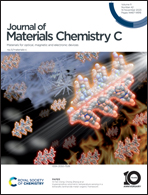Rational molecular design of phenanthroimidazole–azine derivatives for efficient non-doped blue organic light-emitting diodes with low-efficiency roll-off†
Abstract
A family of phenanthroimidazole–azine derivatives (TrBPI, 4PyBPI, 2PyBPI, and 2PyTPI) bearing various kinds of azine acceptors (2,4-diphenyltriazine, 4,6-diphenylpyrimidine, and 2,6-diphenylpyrimidine) are successfully developed. All molecules possess hybridized local and charge-transfer (HLCT) excited states confirmed by theoretical calculations, solvatochromic studies, and transient decay lifetime analyses, giving them blue fluorescence with near-unity photoluminescence quantum yields. By this molecular tunning of the acceptor and π-linker, their emission colors are effectively altered from greenish blue for TrBPI, sky blue for 4PyBPI, blue for 2PyBPI, and deep blue for 2PyTPI. They exhibit intense emissions in neat films with ambipolar charge-carrier-transporting properties with a decent balance of hole (2.91–9.53 × 10−5 cm2 V−1 s−1) and electron (0.98–3.50 × 10−5 cm2 V−1 s−1) mobility and superior thermal properties (T5d = 490–507 °C), furnishing their successful applications as non-doped emitters in OLEDs. These devices exhibit strong sky blue to deep blue electroluminescence (EL) emissions with decent EL performance (an Lmax of 12 590–50 400 cd m−1, an LEmax of 3.85–8.61 cd A−1, and an EQEmax of 3.83–5.29%) and low-efficiency roll-offs at high luminance (EQE@10 000 cd m−2 = 2.61–4.20%). In particular, OLEDs fabricated with 2PyTPI display deep blue emission (λEL = 439 nm and CIE coordinates of (0.157, 0.094)) with an EQEmax of 4.02%. Our results establish that by taking advantage of molecular tuning of phenanthroimidazole–azine derivatives, ambipolar blue HLCT emitters as well as non-doped blue OLEDs with high performance could be realized, which have promising prospects for displays and lighting in the future.



 Please wait while we load your content...
Please wait while we load your content...